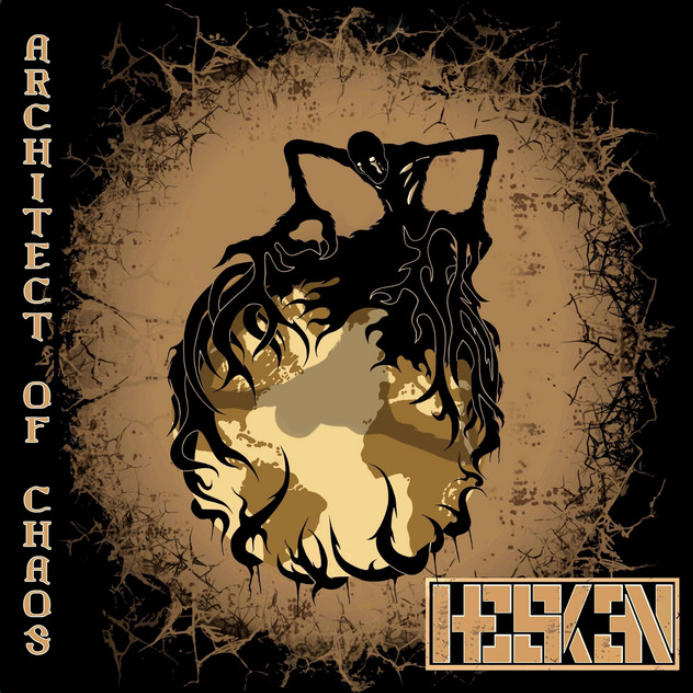Sometimes you have an album where you just have to drop everything and sit down to listen. Architect of Chaos is one of those records. I often listen to an album several times before starting the review, and especially the first few times I heard this record, I really took the time to sit down and listen. There are so many layers and interesting riffs in it that to get everything out of it, you really have to listen carefully. It’s also very nice when an album grabs you so much that you put everything aside just to listen to music. That actually says enough about the quality of the band. Let’s dive into Architect of Chaos together.

HESKEN
HESKEN draws inspiration from various bands, and that inspiration is definitely audible in Architects of Chaos. Dream Theater is clearly present, but Tool, Gojira, and even Thy Art is Murder make appearances at times. The sound is grungy, crunchy, and fortunately NOT as polished as it sometimes sounds in some other productions. However, that doesn’t say anything about the level of instrumental mastery of the band, which is truly on another level and surpasses many bands.
HESKEN manages to blend their progressive influences well with (old school) death metal and other genres, producing a very unique sound. Meticulously crafted and polished, because it sounds like every note on this album has been carefully placed.As befits prog, there are only six tracks on this album, with Dawn of the New Age being the shortest track at just under 5 minutes. In total, the album lasts over 45 minutes.
Architect of Chaos
The album starts calmly with the intro track of The Seeker. After about a minute, the track really begins, with the crunchy guitars of the main riff. However, this track remains mainly groovy, a bit on the slower side, and may even be considered a power ballad. With this track, HESKEN immediately sets the tone by adding some strange progressive breaks halfway through.
With Fearful Leaders, the album really kicks off. The tempo suddenly becomes much higher. The guitar gallops and tight double bass, the clean, strange time signatures lean towards the modern-metal corner. There are even some actual BLEGHS in there. However, with the gritty vocals and guitar melody in the chorus, HESKEN gives it a completely unique twist. It’s quite impressive to completely stop halfway through the track and add an instrumental break. The build-up to the end chorus creates an emotional rollercoaster, making this track one of my favorites right away.
Conspiracy
With Conspiracy, HESKEN shows that Gojira and Tool have certainly influenced this album. However, we also clearly hear the Dream Theater influence in the pre-chorus. As for the progression of the album, Conspiracy leans more towards the groove and mid-tempo. However, this is still a heavy track, especially the pre-chorus. My favorite part of this track is the As Above – In between – So Below section halfway through. Harmen also demonstrates his ability to grunt deeply on this track. During the break, we’re treated to a display of instrumental skills from both the guitarists and the bassist. Even vocal harmonies are included, so not only Harmen but also bassist Marijn shows how versatile they are.
Dawn of the New Age is the first track heard from this band, as it was released online as a YouTube clip last year. This first introduction to HESKEN immediately made me curious, especially because it’s clear from the first notes that we’re dealing with a prog band with unusual time signatures. The Dream Theater influence is strong, but it’s well-inspired and clearly not a copy.
Desolation
Desolation is the longest track on this album at 9.24 minutes. This is again a diverse but above all heavy track. At times, Harmen’s gritty vocals remind us of Chester Bennington. The rhythm for the pre-chorus again reminds us a bit of Conspiracy. However, then follows the most iconic guitar riff of the album, which they then play an octave higher, making it even cooler (kudos to Sven). There’s plenty of room for each instrument to shine on this track. My only feedback for this track would be that there might be a bit too much repetition in the first half of the track, and without that, the track could have been a minute or a minute and a half shorter.
Architects of Chaos ends with Curtain Call, probably the heaviest track on the album. This is definitely the track where the audience goes wild during a live performance. It’s still progressive, but in such a way that it really hits hard. This is probably also the most death-metal track on the album. I’m especially glad that HESKEN kept Architects varied because although this is very cool, I wouldn’t want to miss a track like Conspiracy.”
Final Thoughts
Architect of Chaos is a great debut album from HESKEN. Progressive metal is a hard enough genre as it is, but to display this level of skill in both songwriting and instruments is seriously impressive. HESKEN brings progressive (death?) metal in a way that’s easy to get into for people who aren’t into progressive metal. My favorite track of the album is probably Desolation, although Fearful Leaders and Conspiracy are pretty high on the list as well. But Desolation captures everything HESKEN stands for, so if you’re only going to listen to one track, maybe it should be this one.
You can find HESKEN on their website, on Facebook, or in our database.





